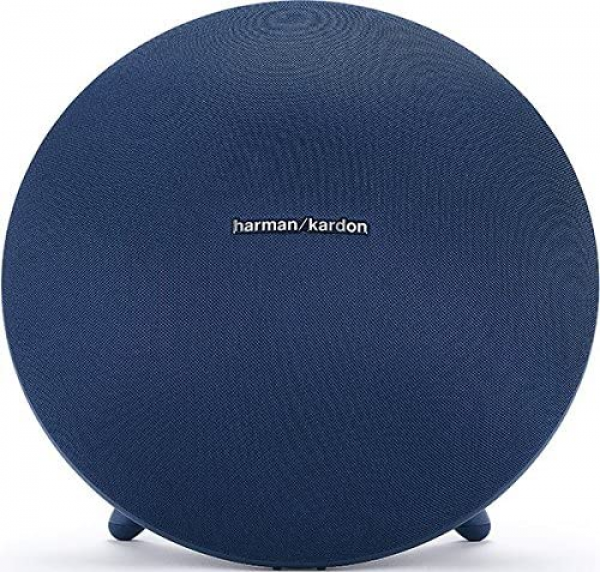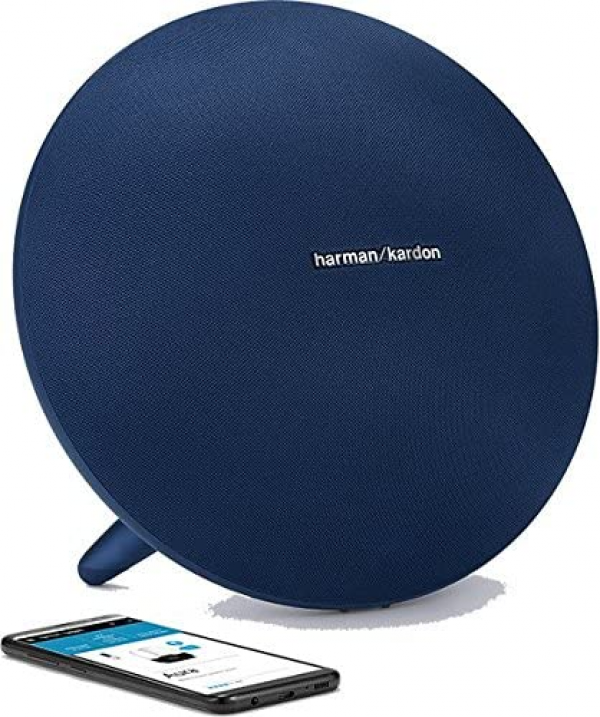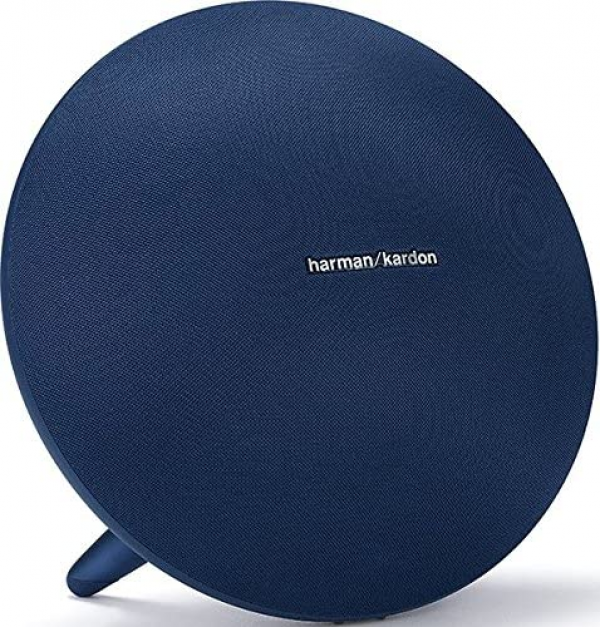Harman/Kardon
Harman / Kardon Onyx Studio 4 transportable speaker: quiet strength
Aprox. 199€
See specificationsFour years after the release of the first Onyx Studio, here is already the fourth iteration of the circular transportable speaker signed Harman / Kardon. Its predecessors were able to convince us with their quality sound performance, combined with an effective design - and a very competitive price. With peace of mind, the Onyx Studio 4 continues this trend.
Positive points
Its balanced and ample.
Good dynamics.
Effective stereo.
Robust construction.
Possibility of grouping or stereo pairing of several speakers via the HK Connect + interface.
Bad points
Small lack of precision in the mids.
Power reserve not as large as you might think.
High latency in Bluetooth, wired ignition delays.
Promise not kept in autonomy.
Our review
Ergonomics
Over the course of its successive incarnations, the Onyx Studio has retained its emblematic circular shape, gradually adopting more and more refined and simplified lines. An evolution that now leads to this fourth version of a minimalism quite attractive - and extremely similar to the Onyx Studio 3. This minimalism is supported by an assembly and materials which, failing to breathe great luxury, are of sufficient quality. We also appreciate the exclusive use of mat or rubbery plastics, insensitive to fingerprints - even if that does not prevent the white version of the enclosure tested here from being quite messy. On the other hand, not the least IP certification on the horizon, therefore no guarantee of resistance to dust or water. Let there be no mistake: although it is transportable, the Onyx Studio 4 is not destined for mobile use.
Compatible with Bluetooth 4.2, the Onyx Studio 4 is able to connect to two sources simultaneously, the stream broadcast being that which comes from the last source on which a playback was started. This compatibility is complemented by a single auxiliary input on 3.5 mm stereo mini-jack - a bit sparse for a speaker of this size. Like all Harman / Kardon Studio-labeled wireless speakers, the Onyx Studio 4 ignores any form of network connectivity.
This does not mean that it is completely devoid of any advanced functionality. The speaker is indeed compatible with the HK Connect + system; it can therefore be grouped with up to 99 other compatible speakers, which will thus be able to synchronously broadcast the signal from a single Bluetooth source. By using the HK Connect mobile app on iOS or Android, it is also possible to pair two Onyx Studio 4 in a stereo pair. Having only had one speaker at our disposal for this test, we unfortunately could not test these two functions.
The control buttons located on the top of the speaker lack only one functionality to be described as exhaustive: the return to the previous track. Strangely, it is however possible to go to the next track - by double pressing the call accept button.
Said pickup button also by default serves as a play / pause button. An option offered in the HK Connect application allows you to assign it another functionality, namely calling the voice assistant. However, we must admit that we do not see the interest of this option ... since even in play / pause mode, the assistant's call is still possible, simply by long press on the same button, and this both on iOS and Android!
The Onyx Studio 4 has a microphone for use as a hands-free kit. The latter offers honest voice capture, but its quality is still far from ideal - partly due to the low sampling frequency used, at only 8 kHz. The voices are deprived of a considerable portion of their harmonics, therefore their timbre (for a better understanding, see the part dedicated to the timbre in our tutorial "How to read a frequency response curve?"). Added to this is a little too aggressive noise reduction. However, the intelligibility of voice communications remains correct.
But the real annoyance comes from autonomy: promised at 8 o'clock by the manufacturer, it did not rise during our measurement until ... 3:30! Let us admit that said measurement was carried out at a relatively high sound volume (approximately 60% of the maximum volume), and that one can perhaps grab one or two additional hours by lowering the level of a few decibels. Very disappointing in absolute terms, this result is not, however, so disturbing on a daily basis, due to the "portable but not nomadic" vocation of the speaker: rare are ultimately the situations where one would like to use it in a way extended away from a power outlet.

Audio
It was pointed out that little had changed in terms of design between the Onyx Studio 3 and the Onyx Studio 4. And what about the sound? You can imagine: the similarities continue.
So here we find an acoustic design similar to that used since the very first Onyx: on the front, two 2 cm tweeters and two 7.5 cm woofers produce stereo sound, while at the rear, a bass radiator passive aluminum reinforces the bottom of the spectrum . Together, all these speakers produce a sound of a beautiful balance, just colored by a small reinforcement of the frequency response in the mids, between 500 and 1000 Hz. A consequence of the lack of control of the membranes in this region? It is possible: at Onyx Studio 2, we criticized a slight lack of precision in the mediums at the time, and this criticism is unfortunately still valid today. Medium instruments, and in particular human voices, may thus lack a bit of naturalness and fishing in their joints. Fortunately, the stamps on the other hand are generally very well respected.
This defect is mainly observed when the speaker is set to a very high volume. Bulky, the Onyx Studio 4 is nonetheless a portable speaker, and its power reserve is not very spectacular. If you agree to lower the sound volume by a few decibels, the acoustic behavior of the speaker significantly improves: this is shown by our harmonic distortion measurement normalized to 79 dB SPL instead of 85. Also note on the curve frequency response the slight rise in low frequencies: it reflects the greater ease that the bass radiator then has in monitoring the range of motion of the active speakers. By ear, the low frequencies are then adorned with much improved reactivity and dynamics - and quite pleasant.
We can thus fully enjoy a rich and full sound, which certainly does not shine by the level of detail it offers to admire, but is still very pleasant in terms of breadth. The latter also benefits from a surprisingly effective stereophony: the Onyx takes advantage of the domed shape of its facade, because the left and right channels thus radiate in divergent directions. The reverberation of the sound waves in the listening room means that the sound scene manages to unfold in width, certainly very imprecise, but still beneficial for immersion.
The latency in Bluetooth is around 335 ms. It's a lot; significantly above average for this type of product, and far too much to allow viewing of a video without compensation for the sound / image offset. And if the auxiliary input does not suffer from any latency, it nevertheless suffers from this lack of velocity: the speaker switches off automatically as soon as it detects a zero signal ... and is then very slow to reactivate when it receives useful signal again - it takes a good half second of inertia. When watching a film, this means that every moment of silence can be followed by a delay in turning on the speaker when the sound resumes: needless to say, the thing is somewhat annoying. Know therefore that the Onyx Studio 4 must be considered as a speaker dedicated to pure musical listening, and in no way to viewing audiovisual content.

Conclusion
No revolutions in sight for the Harman / Kardon Onyx Studio 4 speaker, the main quality of which is ultimately its maturity. Its design and ergonomics are simple and effective, its audio performance is quite solid. Add to that a very reasonable price, and you get anyway a benchmark for value for money in the category of large transportable speakers - despite the disappointment related to autonomy, far from keeping its promise.

Specifications

